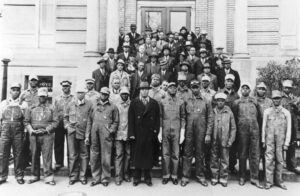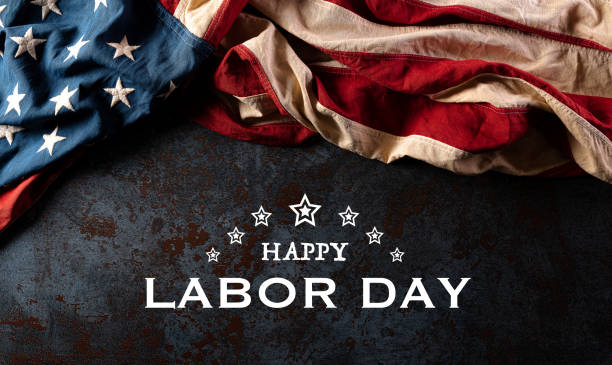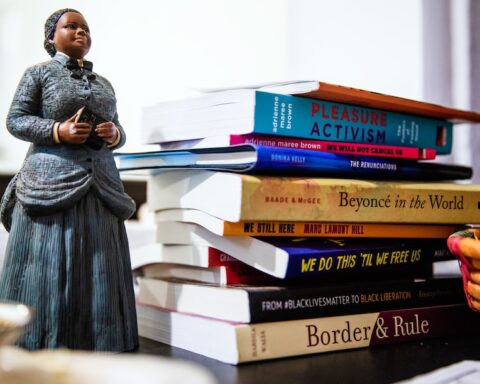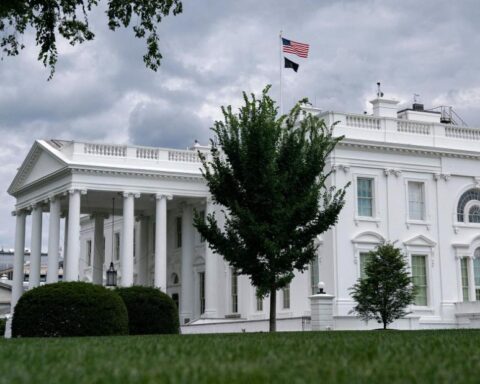“Racism is part of our inheritance as Americans. Every city, every state and every region of this country has its own deep history with racism. And so does the labor movement.”
–Richard Trumka, Missouri AFL-CIO Convention
America’s Declaration of Independence asserts that “all men are created equal” and “that they are endowed by their Creator with certain unalienable Rights…Life, Liberty and the pursuit of Happiness.” Yet our founding fathers, some of whom were slave-owners, incorporated slavery into our political institutions and defended it for almost a century. And after race-based slavery was finally outlawed, a new generation of political elites allowed a new race-based system of coerced labor to become law and remain in place for another hundred. The legacy of prejudice that was produced and reinforced by slavery and Jim Crow continues to shape American political institutions and thinking in profound ways.
Yet throughout our history, ordinary women and men fought and died for a racially inclusive vision of economic justice. Abolitionists, textile workers, train porters, Knights of Labor, tenant farmers, miners, auto workers and sanitation workers lived their commitment to racial equality and joined together to demand a better, more just America.
Progressive race leaders like Fredrick Douglass, W.E.B. Dubois, A. Philip Randolph and Rev. Dr. Martin Luther King Jr. saw unions as essential to the ability of black workers to rise and achieve equality. And progressive labor leaders like John Lewis and Walter Reuther knew the labor movement could not be whole without the participation of black workers.
Both union and civil rights activists understood that labor rights are human rights, and that to constrain a person’s liberty—to choose one’s work, to earn enough to support a family, to marry, to travel—is a deliberate act of coercion. This kind of violence is easier for the slaver to rationalize if the enslaved is viewed as less than human.
The story of race and labor in America starts with the treatment of black workers in the South. That region’s cultural isolation from, but continuing political and economic influence on the rest of the country continues to this day. When African Americans moved north in the 20th century over the course of two world wars and the Great Depression, they found more personal freedom—but they also found ongoing discrimination and unequal access to economic opportunities. In the decades between the two wars, business interests deliberately used race and ethnic differences to undermine labor unity. Some unions responded by embracing integration; others resisted.
Even after civil rights legislation finally made racial discrimination illegal in the 1960s, conservative politicians used racial stereotypes and white fear and anxieties to divide working people. They continue to do so today. The labor movement can and must be at the forefront of efforts to push back against the politics of division. We owe it to our members, our children and our country.

THE SOUTH
Relatively early in colonial America, Southern landowners recognized that they could maximize their profits by using African slaves to work their land, and a body of law was implemented to rationalize permanent race-based enslavement. Over the years, after every real or imagined slave uprising, these laws were made harsher, and black workers were further stigmatized and dehumanized. Slave rebellions were terrifying to the political authorities, not only because of physical danger they represented to a minority white elite, but because they exposed the violence required to maintain slavery as a system.
It took almost one hundred years of agitation, resistance, political organizing and the bloodiest war of our nation’s history to end that “most peculiar institution.” But the defeat of the Confederacy did not permanently destroy the power of southern landowners or their ideology of racial superiority.
When the Civil War ended, Confederate officers returned to their plantations and immediately established “black codes” that limited a black person’s right to hold property, teach, preach or travel. In other words, the new laws snatched back the liberty of newly freed slaves, and punished those who refused to bend. Thousands of freed people who tried to leave plantations or refused to work at the terms offered were murdered in the first years after emancipation.
The “Reconstruction” of the South only began when federal troops occupied former Confederate states in 1867 and demanded former confederates pledge loyalty to the union or lose their political rights. With the protection of federal troops and the help of the Freedman’s Bureau, black freedmen voted and participated in government for the first time. In their first experiment with self-government, they established public schools, established aid societies, rebuilt roads and raised taxes to pay for it. Had the integrated state legislatures they voted in been allowed to continue, some of our most progressive social and labor legislation might have come from the South. But after the human and financial cost of the Civil War, the federal government was unable or unwilling to keep enough federal troops in the South to suppress white on black violence. As whites won back their voting rights and suppressed black voting, Congressional support for Reconstruction shrank. After 10 years, Congress voted to withdraw troops from the region and let the old caste system reassert itself.
The planter class established a new system of sharecropping and debt peonage (backed up by the very real threat of the chain gang) to keep black workers on the land. Jim Crow laws guaranteed social and physical segregation from whites and prevented most black people from acquiring a decent education, competing for jobs, or building wealth. Lynching became a tool of social control and economic domination, spiking during the season property owners and sharecroppers settled accounts. By 1910, the South once again had become a powerful conservative voting bloc in Congress, one that consistently blocked labor rights and social reforms.
INDUSTRIALIZATION AND UNIONS
In the rest of the country, the Civil War economy increased the pace of industrialization and unleashed a new spirit of acquisition and accumulation. Under unregulated capitalism, the ruthless reaped the greatest rewards. Carnegie, Vanderbilt, Morgan and Rockefeller monopolized whole industries—steel, railroads, finance and oil. They built large industrial works that reached across the continent. Using force, fraud and unscrupulous business practices, they crushed competitors. They then colluded with each other to control the costs of production and the prices charged to consumers. Openly buying politicians to ensure they could write the economic rules and stack the deck in their favor, they accumulated unimaginable wealth. And they then fought fiercely to keep it.
In the second half of the 19th century, immigrants from Ireland, Italy and Eastern Europe crowded into tenements in Boston, Chicago, New York and Philadelphia while Chinese immigrants were herded into “Chinatowns” in San Francisco. Immigrants were consigned to large, dangerous factories, and paid wages that fluctuated with regular recessions, making them ripe for union organizing and all manner of radical ideas like a 40-hour work week and rising wages.
The new industries, larger factories and denser population centers created fertile ground for rapid union growth. A greater concentration of skilled workers in one place allowed traditional craft unions to grow, and large factories put multiple trades under one roof, enhancing the potential for federated structures like the one that would become the American Federation of Labor. The skilled trades still were overwhelmingly native-born white Protestant males in the 19th century; and because they earned relatively higher wages, they were able to pay dues for strike funds, sick pay, unemployment assistance and burial insurance. They were reluctant to organize unskilled Irish and Italian Catholic immigrants.
Other unions did so enthusiastically. The Knights of Labor, founded in 1869, wanted to organize allworkers—skilled and unskilled, men and women, white and black—within an industry. They taught immigrants their rights as citizens, built cooperatives, provided economic education and promoted political reform. A railroad strike the Knights of Labor organized became a turning point in industrial conflict.
A Knights’ wildcat strike in 1877 eventually embraced 100,000 workers, but ended in riots, property damage and state militia and federal troops being called out in seven states. After the Pittsburgh militia fired into a crowd and killed several people, workers retaliated by destroying 39 buildings, 104 locomotives and 1,245 train cars. At the strike’s end, 100 to 200 people were dead and many hundreds more were injured or imprisoned.
Before this event, strikers rarely faced more than light fines and brief jail terms. But industrialists were irate at the destruction of their property. They reorganized state militias, built local armories, developed ties with the army and built their own private security forces, complete with spies and strikebreakers. This marked the beginning of a very violent fight over the right of workers to a union and to demand higher wages and shorter work days.
In the last two decades of the 19th century, more than six million workers were involved in 23,000 strikes. Militia, police, federal troops and Pinkerton detectives often beat and shot strikers, who responded with sabotage, pickets, boycotts and attacks on scabs or strikebreakers. Violent battles were a regular occurrence in the coal fields of Colorado, West Virginia and Pennsylvania between 1900 and 1925; in street car strikes between 1895 and 1929; and in major steel strikes in 1909 and 1910. The Triangle Shirt Waist factory fire killed 146 girls in New York City in 1911, and 30,000 women marched for Bread and Roses in 1912. The scale and scope of industrial action was huge. Outside of California, the army of industrial workers striking and fighting in the early 20th century was predominantly white, although ethnically, religiously and politically diverse. This soon would change.
BLACK WORKERS MOVE NORTH
In 1910, 90 percent of African Americans lived in the South, the vast majority were sharecropping in rural areas. But hostilities in Europe had almost stopped the flow of white workers to northern factories, while increasing the demand for product from munitions and weapons manufactures. This gave unions more negotiating power, and wages were inching up. So employers started recruiting black workers from the south as strike breakers and replacement workers. About a half-million black workers moved to Chicago, Detroit, Ohio, Philadelphia and St. Louis between 1910 and 1920.
The worst recorded incident of labor-related racial violence occurred in St. Louis in 1917. When the Aluminum Ore Company brought in African American workers to break a strike, 3,000 white union members marched in protest. The marchers morphed into a mob, attacking random black residents on the street. The following day, shots were exchanged between whites and black in the black part of town; two plainclothes police officers were killed. When the news got out, roving white mobs rampaged through black East St. Louis, burning homes and businesses, and assaulting men, women and children. Between 100 and 200 black working people died and 6,000 were left homeless. It foreshadowed things to come.
A year later, four million soldiers returned from World War I. With no plan for absorbing them into the economy, unemployment rose rapidly. Both white and black veterans felt betrayed. In the “Red Summer” of 1919, 38 separate race riots occurred, all of them white mobs attacking blacks. The worst riot occurred in Chicago. After a black youth was stoned for swimming into the “white” part of the lake, Irish and black gangs battled each other for 13 days. When it was over, 23 blacks and 15 whites were dead, 537 were injured and 1,000 black families were homeless. Across the country, more than 100 people died that summer, while scores of black homes and businesses were destroyed.
The attorney general responded by initiating a series of raids against (immigrant) “anarchists, Bolsheviks and radicals,” arresting thousands and deporting more than 500. Historical records show federal law enforcement officials were terrified of a Bolshevik revolution in the United States and feared black Americans would be attracted to Communism’s radical egalitarianism.
With World War I over, the business community closed ranks and honed its anti-union tactics. When the AFL struck U.S. Steel in the fall of 1919, shutting down half the steel mills in the country, management used every dirty tactic available to them. It smeared the union leaders in the press by calling them Reds and Bolsheviks; derided the striking workers because they were immigrants; and encouraged local and state militia to intimidate and harass the strikers. The original race card players, they brought in 30,000 to 40,000 African Americans and Mexican-Americans as strike breakers, and taunted the locked-out strikers for losing their good “white” jobs. This would be the Big Business’ playbook for decades.
NEW DEAL ADVANCES, RACE-BASED EXEMPTIONS, AND THE END OF JIM CROW
In October 1929, the stock market crashed and $30 million in stock value disappeared. Within 10 months, 744 banks had failed. At the depth of the Great Depression, one of every four workers was jobless.
Under popular pressure, Republicans passed two important pieces of legislation. The first, the Davis-Bacon Act of 1931, required federal contractors to pay their workers the wages and benefits that “prevail” in a locality. The Norris-LaGuardia Act of 1932, the second piece of legislation, made it illegal for companies to require workers to sign “yellow dog” contracts promising not to join a union. It also prohibited courts from issuing injunctions against strikes.
In 1932, Roosevelt won resoundingly with coalition that relied on the support of white ethnic union members, African American workers and conservative southern Democrats. His New Deal established the legal foundation for our current labor laws, employment standards and social insurance programs, but due to southern Democrats, this legal edifice was deeply flawed.
When the National Industrial Recovery Act (NIRA) provided federal money to fund local public relief project employment, predominantly black agriculture and domestic workers were excluded from getting NIRA public relief work. The Fair Labor Standards Act also excluded agricultural, domestic and tipped workers from wage and hour laws, covering only 20 percent of all workers in the end. The Social Security Act established unemployment insurance, pensions and support for the disabled, widows and orphans. Social Security has uniform rules administered by the federal government, but the rules and benefit levels of the other social safety net programs are set by state governments and administered by state employees. Southern states could and did create rules that excluded African Americans from participating.
By contrast, the 1935 National Labor Relations Act (Wagner Act) guaranteed all workers the right to join a union and bargain collectively, and created an oversight board to approve union elections and define fair labor practices. With fair referees, union density tripled in a decade to 35.4 percent of all wage and hour workers. But the National Labor Relations Board was only effective when the members believed in labor rights; when anti-union members were appointed to the NLRB, it stopped working for working people.
By 1940, America again was gearing up for war. A. Phillip Randolph, head of the Brotherhood of Sleeping Car Porters, the largest and most powerful black union in the country, was determined that African American workers would benefit from the expansion of the defense industry. In 1941, after he threatened to march 50,000 black men to Washington to protest their exclusion from production jobs, Roosevelt banned discrimination in defense factories and even established a Fair Employment Commission to enforce his executive order.
But in June 1943, when managers at the Packard company in Detroit actually promoted a few black workers, 25,000 white workers went on strike. Similar racial conflicts erupted in mass transit unions in Philadelphia, in steel plants in Baltimore and in the shipyards of Alabama when black workers gained access to production jobs. This time, labor leaders, especially Congress of Industrial Organizations (CIO) leaders, worked hard to suppress “hate” strikes and were fairly successful.
Soon after, W.E.B. DuBois, documenting the ability of union solidarity to overcome racial animus, noted that “[union] men…in steel and automotive industries have been thrown together, black and white, as fellow workers striving for the same objects. There has been on this account an astonishing spread of interracial tolerance and understanding. Probably no movement in the last 30 years has been so successful in softening race prejudice.” The NAACP worked closely with the UAW to integrate Ford and supported the sit-down strike at its River Rouge plant in 1941.
As defense and production jobs opened up to African Americans, the second half of the Great Migration of black workers from the south to the north exploded. And CIO unions went south.
The CIO broke away from the AFL in 1935 because the industrial unions were committed to a broader, more inclusive vision of organizing—white and black; skilled and unskilled. The CIO recognized the regressive influence the South had on national politics and launched “Operation Dixie,” a massive union drive in 12 Southern states in 1946 to try to break the conservative culture of the region. They hoped to protect wage gains in the North by raising wages in the South. (Some companies were moving south to avoid unions.) Despite bringing in hundreds of experienced organizers, Operation Dixie failed—due to Jim Crow laws, white prejudice, the coercive tactics of local authorities and new anti-labor legislation passed by a Republican Congress.
The Labor-Management Act of 1947 (Taft-Hartley), outlawed wildcat strikes, mass picketing and secondary boycotts—tactics used to win union recognition. The act gave managers the right to force employees to attend anti-union meetings, and approved laws in 11 states that allowed employees to opt out of paying union dues. Union organizing stagnated.
In the meantime, the civil rights movement gained momentum. A. Philip Randolph and other race leaders pressured President Truman to desegregate the armed forces and he did so in 1948. In 1954, the Supreme Court declared “separate but equal” unconstitutional—finally. Local activists began pushing for equal treatment in the Deep South, starting with Rosa Parks refusing to give up her seat to a white man, thus setting off a two-year bus boycott in Montgomery, AL, which nearly bankrupted public transportation in the city until it finally agreed to equal seating.
When the AFL and CIO merged in 1955, hundreds of thousands of black trade unionists became part of an integrated labor movement. George Meany became its first president and A. Philip Randolph became its first vice president. The Sleeping Car Porters and UAW were among the first supporters of the new Southern Christian Leadership Conference led by Rev. Dr. Martin Luther King Jr. They also supported the Woolworth counter sit-ins by the Student Nonviolent Coordinating Committee, and Freedom Rides organized by the Congress of Racial Equality in the summer of 1961. Randolph and other black trade unionists helped plan, organize and fund King’s 1963 March on Washington for Jobs and Freedom where he delivered his “I Have a Dream” speech. In their commitments and vision, these black trade unionists linked the priorities and interests of the labor movement with demands for racial equality.
THE 1960S: ADVANCES AND DISRUPTIONS
John Kennedy recognized that labor had been crucial to his winning the presidency in 1960, and created a National Labor Relations Board (NLRB) that would be true to its original mission. His NLRB restricted anti-union propaganda at the workplace, allowed picketing, increased the penalties for violating labor law and banned employer lockouts as an “unfair labor practice.” Most importantly, it ruled that if a majority of workers signed a card saying they wanted to join a union, the union would be recognized.
Kennedy also established collective bargaining rights for federal employees in 1962. Although limited in scope, it spurred state and municipal public-sector union organizing just as anti-discrimination rules were opening up public-sector jobs to African Americans and Great Society programs were expanding public-sector jobs. In 1960, only two percent of state and local public employees had the right to bargain collectively; by 1990, more than two-thirds did. The rapid expansion of public-sector unions has been a boon to both the labor movement and the growth of the black middle class.
After Kennedy’s assassination, Lyndon Johnson won the 1964 election with the largest vote advantage since 1824 and a veto-proof majority in both chambers of Congress. He did not waste his opportunity. His administration was responsible for
- outlawing employment discrimination based on race, color, religion, sex or national origin;
- desegregating public accommodations;
- prohibiting poll taxes and other tools Southern states used to restrict voting;
- requiring federal contractors to “affirmatively act” to hire more African Americans;
- prohibiting discrimination in rental housing and mortgages;
- establishing Medicare for the elderly, Medicaid for the poor, food stamps, Head Start, the Jobs Corp, and federal aid to poor primary and secondary schools and farm families;
- investing in public universities, urban mass transit, job training, urban renewal programs and housing subsidies;
- abolishing national-origin quotas in immigration law; and
- establishing clean air and water quality standards, safety standards on cars, fair labeling, food safety standards and consumer lending regulations.
For labor, Johnson extended labor standards to cover nine million more workers, improved Davis-Bacon and increased the federal minimum wage. But labor density did not grow.
The 1960s were a time of conflict and division. Many white people were not comfortable with the anti-war protests or the pace of racial change. And many African Americans in the North were not, either. They celebrated the end of de jure segregation in the South, but were increasingly frustrated with the de facto housing and school segregation, job discrimination and police brutality in their own lives.
With the rise of new social movements, anti-war activism, Black Liberation, Black Nationalism and the women’s movement, the country was deeply divided—and still reeling from President Kennedy’s assassination. Many suspected government involvement when Malcolm X was assassinated in 1965. Later that year, a riot in Watts broke out after an incident with the police; 34 died, most of them black.
During the “long hot summer” of 1967, more than 159 urban disturbances occurred in black neighborhoods, most of them related to violent encounters between white police and black residents of inner city neighborhoods with high rates of unemployment. The worst riots occurred in Cleveland, Detroit and Newark, NJ. More than 100 people died, and thousands were injured—the great majority of those killed or injured were black.
Dr. King recognized that the end of legal segregation was just a battle in the struggle for full equality, and that good jobs were the key to black advancement. He strongly believed in unions as a mechanism for higher wages and economic opportunity. He was speaking in support of the “I Am a Man” strike of black Memphis sanitation workers—AFSCME members—when he was assassinated in 1968.
In the immediate hours after Dr. King’s killing, rioting erupted in 130 cities. Dozens of people died, but the 65,000 federal and National Guard troops called out to quell the violence were told not to shoot looters, so the death toll was less than it might have been. Two months later, Robert F. Kennedy was assassinated. In August, the nation watched four days of fighting between protesters and police at the Democratic convention in Chicago; more than 1,000 were injured and 600 arrested. In October, 100,000 white students marched against the war in Vietnam. Some protesters and police tussled, and more than 650 people were arrested.
In the Kennedy-Johnson years, labor and civil rights leaders fought together for racial justice, labor rights, public investments in infrastructure and training, better retirement security, better access to college and health care and anti-poverty initiatives. Both black and white poverty rates were cut by half (from 55 percent to 27 percent, and from 20 percent to 10 percent, respectively), but union density continued to fall.
The nation went to the polls in 1968 deeply disturbed and divided. George Wallace, a white supremacist, ran as a third-party candidate and won almost 10 million votes (12 percent) and five states. Only 500,000 votes divided Nixon from Humphrey, but Nixon won an electoral landslide and declared a mandate.
THE LONG BACKLASH
Starting with Richard Nixon and extending to Donald Trump, conservative politicians wrote a new playbook: activate racial fears, while lifting up white people as “the silent majority,” “real” Americans, “people who play by the rules.” While publicly displaying empathy for “the middle class” or “working people,” instruct your political appointees to dismantle labor protections, restrict union activities and undermine civil rights protections.
Nixon’s campaign call for “law and order” was an unsubtle promise to crack down on black demands for full equality. He spent his first two years increasing federal funds to police departments for anti-riot equipment, and then cut funds for small businesses, education and job training. By 1971, Nixon’s NLRB had undone all of progressive labor reforms that had been established under Kennedy’s NLRB.
Carter won 48 percent of the white vote and 62 percent of the union vote in 1976, but instead of recasting the NLRB or reforming Taft-Hartley, he deregulated the highly unionized trucking, airlines and communications industries. By 1980, private-sector union density had dropped to 20 percent.
When Reagan ran a campaign openly promoting racial stereotypes in 1980, he won 56 percent of the white vote but only 45 percent of the union household vote. In 1981, he fired 11,000 air traffic controllers—who had endorsed him—and banned them for life from federal employment. Reagan’s NLRB ruled employers could hire permanent replacement workers and created a long list of prohibited labor practices. He cut anti-poverty programs, gutted the Civil Rights Commission and appointed conservative Supreme Court judges. In 1984, 66 percent of whites voted to reelect him, but only 46 percent of union households did so. George H.W. Bush opened up immigration and negotiated a North American Free Trade Agreement with no labor protections.
Bill Clinton won the presidency in 1992 with only 39 percent of the white vote (thanks to third-party candidate Ross Perot) but he won 55 percent of union households. Clinton won 44 percent of the white vote and 60 percent of union households in 1996 reelection. His NLRB allowed teaching assistants and temp workers to be able to unionize, and protected union rights when businesses merge. But he ended the guarantee of income assistance for poor families, passed stiff new mandatory drug laws that are responsible for the mass incarceration crisis we now face, implemented NAFTA and deregulated the financial industry.
George W. Bush won 55 percent of the white vote and just 37 percent of union households in 2000. He appointed a union-busting lawyer to chair the NLRB and an anti-labor secretary of labor. In his 2004 reelection, he won 58 percent of the white vote and 40 percent of the union vote. The Bush response to the Katrina disaster in New Orleans demonstrated what many African Americans felt his attitude was on racial justice: black lives in New Orleans did not matter.
Only 39 percent of whites voted for Obama in 2008, but 59 percent of union households did—and more white union members voted for Obama in 2008 than voted for Gore or Kerry. This represented a significant show of solidarity by union members that was repeated in his 2012 reelection.
And labor has been rewarded with the most pro-labor administration since Kennedy-Johnson. Although unable to move the Employee Free Choice Act, other important legislation passed: The Lilly Ledbetter Fair Pay Act, the Affordable Care Act (which improved coverage but needs improvements), the American Recovery and Reinvestment Act and financial reform. The Federal Aviation Authority (FAA) bargained with air traffic controllers, and 40,000 TSA airport screeners won bargaining rights. The Obama administration encouraged insourcing of federal work and gave new funds to worker protection agencies to bolster enforcement.
Obama’s NLRB was staffed with experienced labor lawyers committed to its mission who were able to streamline the election process, reduce opportunities for employer delay and adopt a new standard for joint employer status.
With the election of Donald Trump, all these advances are at risk.
TO SUM
In the past 100 years, labor was able to turn its voting power into a union-supporting political environment in just three administrations—Roosevelt’s New Deal, the Kennedy-Johnson administration and the Obama administration. Each time, labor and African Americans togetherelected a president committed to both economic fairness and racial justice. Each president began had a Democratic Congress for at least part of his term, and a Supreme Court that did not block progressive laws and regulations.
To elect politicians who will establish and enforce rules that make organizing easier, strengthen labor standards and make our economy fairer and more inclusive, we need strong, honest electoral coalitions. In 1976, a quarter of the votes cast in a presidential election came from a union household; today, only one in five does. About two-thirds of union members have voted for Democratic presidents (including 60 percent of white union voters) over the last 50 years, but 85 percent of African Americans did. Communities of color have been our strongest allies. And if we want them to support our issues, we need to support theirs.
Creating a legal environment that protects union rights and prevents discrimination does not mean the absence of conflicts to negotiate. The world is complicated, and some widely held principles of fairness require reconciliation. A particularly thorny example involves the principle of equal opportunity (every person should have the chance to prove himself or herself capable and committed) versus the principle of seniority (people who have demonstrated their competence in and commitment to a job should be rewarded). This potential conflict can play itself out through a racial, gender or simple “new worker” filter.
In an industry or occupation traditionally staffed by white men, management has a deliberate or unconscious bias to recruit individuals who look like themselves. New factory workers are often recruited through the informal and personal networks of the existing staff. This is how implicit (unconscious) bias operates. To recruit more people of color, management must change its recruitment practices and no longer give preference to the friends or relatives of current employees. To the existing workforce, this change could feel like a lost benefit (giving first option in hiring to friends and family). To a worker of color, this would look like favoritism and blocked opportunities.
Today, union workers with the most seniority in many companies are still more likely to be white and male than of-color and female. In this situation, what happens when layoffs occur? According to the seniority principle, those longest on the job stay. But what if their tenure is longer because others were systematically excluded from the hiring process? Those who were not allowed to compete for work are penalized for not getting into the job earlier. “Last hired, first fired” means people will be penalized because of society’s past history of racial discrimination.
In the difficult period after the Great Recession, when many businesses were failing, management demanded benefit and wage give-backs in contract negotiations; some pushed a “two-tiered” system: the employees with the longest tenure were allowed to retain their previously negotiated wages and benefits, but new workers would have to work for less. These arrangements undermine labor solidarity and the wage-raising impacts that collectively bargained contracts that cover everyone equally can have across a factory, an industry and a local labor market. The good news is that as the labor market has tightened and new contracts have been negotiated, unions have worked hard to return to equal wage and benefit packages.
Promoting equal opportunity and ensuring that working people can join a union to represent them on their jobs to enforce labor laws and standards is not a magic cure-all for racial prejudice. When the number of good union jobs decline, the competition for those jobs increase and created tensions across racial lines. Better training of police officers, community policing, and body cameras will not prevent racial profiling and the too-quick resort to violence by every police officer. The solutions to these thorny issues will be found as we talk to each other, practice radical empathy and share our fears and aspirations at work, in our union halls and in our neighborhoods.
Police violence against black people has been a problem in America since the first Africans were brought here. A century ago, state violence was a problem for striking union members, too. (And some observers said if the workers had not been striking, they would not have been shot.) The activism of young African Americans that started in 2012 with the killing of 17-year-old Trayvon Martin was inspired by the same sentiments that motivated early unionists: “This is wrong. We won’t accept this anymore. Our lives matter, and we have a right to expect more.”
Every successful social reform movement in American history—including the labor movement—began when Americans stood up and fought together for a better future. United we stand.
Promoting equal opportunity and ensuring that working people can join a union to represent them on their jobs to enforce labor laws and standards is not a magic cure-all for deep-seated racial prejudice. When the number of good union jobs decline, the competition for those jobs increase and can play out across racial lines.
Better training of police officers, community policing, and body cameras will not prevent racial profiling and the too-quick resort to violence by every police officer. Police violence against black people has been a problem in America since the first Africans were brought here. (It is important to remember that a century ago, state violence was a problem for striking union members, too. And some made familiar-sounding claims about the strikers, saying that if the workers had not been striking, they would not have been shot.) The solutions to these thorny issues will be found as we talk to each other, practice radical empathy and share our fears and aspirations at work, in our union halls and in our neighborhoods.
Every successful social reform movement in American history—including the labor movement—began when Americans stood up and fought together for a better future. The activism of young African Americans that started in 2012 with the killing of 17-year-old Trayvon Martin was inspired by the same sentiments that motivated early unionists: “This is wrong. We won’t accept this anymore. Our lives matter, and we have a right to expect more.”





